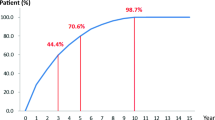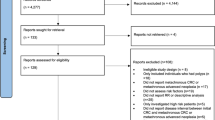Abstract
Background
The risk of metachronous colorectal cancer in patients with colorectal cancer is higher than the rate of sporadic colorectal cancer in the average population. We conducted a large-scale, population-based study, with many more clinical cases than in previously published studies, to calculate the incidence of metachronous colorectal cancer.
Methods
This is a retrospective study based on data obtained from the Taiwan Cancer Registry from 1988 to 2007. Between 1988 and 2002, we analyzed 70,906 patients who were diagnosed with colon or rectal cancer and traced the occurrence of metachronous lesions with at least 5 years of follow-up.
Results
Of these patients, 1,192 (730 males, 462 females; mean age 62.73 ± 12.92 years) developed metachronous cancers. The 15-year cumulative incidence of metachronous cancer was 1.68%. Within 2 years of the index cancer, 51.69% of the metachronous cancers appeared, and 61.27% of the metachronous cancers appeared within 3 years.
Conclusions
Most metachronous lesions were noted within 3 years of initial diagnosis of the index cancer. Surveillance colonoscopy to ensure the absence of metachronous disease is essential for patients after curative surgery within 1 year, especially for those patients who did not receive complete colonoscopy before their first operation for colorectal cancer.



Similar content being viewed by others
References
Cali RL, Pitsch RM, Thorson AG et al (1993) Cumulative incidence of metachronous colorectal cancer. Dis Colon Rectum 36:388–393
Agrez MV, Ready R, Ilstrup D et al (1982) Metachronous colorectal malignancies. Dis Colon Rectum 25:569–574
Kiefer PJ, Thorson AG, Christensen MA (1986) Metachronous colorectal cancer: time interval to presentation of a metachronous cancer. Dis Colon Rectum 29:378–382
Luchtefeld MA, Ross DS, Zander JD et al (1987) Late development of metachronous colorectal cancer. Dis Colon Rectum 30:180–184
Evers BM, Mullins RJ, Matthews TH et al (1988) Multiple adenocarcinomas of the colon and rectum: an analysis of incidences and current trends. Dis Colon Rectum 31:518–522
Juhl G, Larson GM, Mullins R et al (1990) Six-year results of annual colonoscopy after resection of colorectal cancer. World J Surg 14:255–260
Pramateftakis MG, Hatzigianni P, Kanellos D et al (2010) Metachronous colorectal cancer. Tech Coloproctol 14:63–64
Cuniffe WJ, Hasieton PS, Tweedie DEF et al (1984) Incidence of synchronous and metachronous colorectal carcinoma. Br J Surg 71:941–943
Bussey HJ, Wallace MH, Morson BC (1967) Metachronous carcinoma of the large intestine and intestinal polyps. Proc R Soc Med 60:208–210
Heald RJ, Lockhart-Mummery HE (1972) The lesion of the second cancer of the large bowel. Br J Surg 59:16–19
Travieso CR Jr, Knoepp LF Jr, Hanley PH (1972) Multiple adenocarcinomas of the colon and rectum. Dis Colon Rectum 15:1–6
Moertel CG, Bargen JA, Dockerty MB (1958) Multiple carcinomas of the large intestine. A review of the literature and a study of 261 cases. Gastroenterology 34:85–98
Park IJ, Yu CS, Kim HC et al (2006) Metachronous colorectal cancer. Colorectal Dis 8:323–327
Ballesté B, Bessa X, Piñol V et al (2007) Detection of metachronous neoplasms in colorectal cancer patients: identification of risk factors. Dis Colon Rectum 50:971–980
Maruyama H, Hasuike Y, Furukawa J et al (1992) Multiple colorectal carcinomas and colorectal carcinoma associated with extracolonic malignancies. Surg Today 22:99–104
Fukutomi Y, Moriwaki H, Nagase S et al (2002) Metachronous colon tumors: risk factors and rationale for the surveillance colonoscopy after initial polypectomy. J Cancer Res Clin Oncol 128:569–574
Parry S, Win AK, Parry B et al (2011) Metachronous colorectal cancer risk for mismatch repair gene mutation carriers: the advantage of more extensive colon surgery. Gut 60:950–957
Safi F, Beyer HG (1993) The value of follow-up after curative surgery of colorectal carcinoma. Cancer Detect Prev 17:417–424
Rex DK, Kahi CJ, Levin B et al (2006) Guidelines for colonoscopy surveillance after cancer resection: a consensus update by the American Cancer Society and US Multi-Society Task Force on Colorectal Cancer. CA Cancer J Clin 56:160–167
Morson B (1974) President’s address. The polyp-cancer sequence in the large bowel. Proc R Soc Med 67:451–457
van Rijn JC, Reitsma JB, Stoker J et al (2006) Polyp miss rate determined by tandem colonoscopy: a systematic review. Am J Gastroenterol 101:343–350
Farrar WD, Sawhney MS, Nelson DB et al (2006) Colorectal cancers found after a complete colonoscopy. Clin Gastroenterol Hepatol 4:1259–1264
Bressler B, Paszat LF, Chen Z et al (2007) Rates of new or missed colorectal cancers after colonoscopy and their risk factors: a population based analysis. Gastroenterology 132:96–102
Kaminski MF, Regula J, Kraszewska E et al (2010) Quality indicators for colonoscopy and the risk of interval cancer. N Engl J Med 362:1795–1803
Milsom JW, Shukla PJ (2011) Should intraoperative colonoscopy play a role in the surveillance for colorectal cancer? Dis Colon Rectum 54:504–506
Salz T, Weinberger M, Ayanian JZ et al (2010) Variation in use of surveillance colonoscopy among colorectal cancer survivors in the United States. BMC Health Serv Res 10:256
Viehl CT, Ochsner A, von Holzen U et al (2010) Inadequate quality of surveillance after curative surgery for colon cancer. Ann Surg Oncol 17:2663–2669
Scheer A, Auer RA (2009) Surveillance after curative resection of colorectal cancer. Clin Colon Rectal Surg 22:242–250
Acknowledgments
This study was supported by a grant from Landseed Hospital (LS-2010-18).
Conflict of interest
The authors declare that they have no conflict of interest.
Author information
Authors and Affiliations
Corresponding author
Additional information
T.-A. Chen and J.-T. Horng contributed equally to this work.
About this article
Cite this article
Chen, TA., Horng, JT. & Lin, WC. Metachronous colorectal cancer in Taiwan: analyzing 20 years of data from Taiwan Cancer Registry. Int J Clin Oncol 18, 267–272 (2013). https://doi.org/10.1007/s10147-011-0373-5
Received:
Accepted:
Published:
Issue Date:
DOI: https://doi.org/10.1007/s10147-011-0373-5




